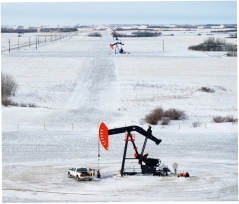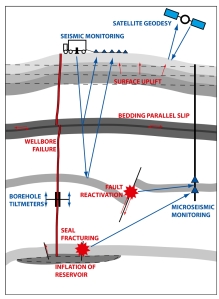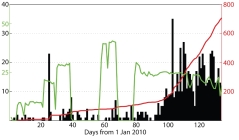Scientists spotlight rock’s role in carbon capture success
July 13, 2013 — andyextance

Equipment for monitoring seismic activity being deployed in a borehole at the Weyburn CO2 storage site in Saskatchewan, Canada. Credit: University of Bristol
Climate change is a problem that many would like to bury – and indeed ‘burying’ CO2 deep underground might be needed to get it under control. And injecting the greenhouse gas among the rocks below us on a large scale is a serious option, if the storage sites are chosen carefully. That’s according to a study of three sites where ‘carbon capture and storage’ (CCS) has been done, published by University of Bristol’s James Verdon and his teammates this week. “Too often CCS is seen as a binary thing – it’ll either be brilliant or hopeless, depending on whether you are for or against,” James told me. “This study shows that every CCS site will be different – there won’t be a one size fits all solution.”
Scientists think it will be dangerous if global temperatures go more than 2°C above the pre-industrial average from 1850-1899. That’s recognised by governments in a non-binding climate change target in the Copenhagen Accord in 2009, where many also pledged actions to cut their CO2 emissions. But we continue to pump out ever more CO2, making the chances of sticking to the target through emission cuts alone ever slimmer.
CCS, which captures CO2 where lots would otherwise be released and then stores it where it can’t reach the air, is an alternative approach. Though the cost of the technology needed to do this has meant projects have been delayed and even abandoned, eight large-scale CCS projects are operational today. James has worked at two: Weyburn in Canada, and In Salah in Algeria. At a meeting of British CCS scientists he mentioned this to Andy Chadwick from the British Geological Survey in Nottingham, who had worked at the Sleipner CCS project in Norway. They realised that comparing the sites could help answer one of the biggest potential issues around CCS beyond cost: how rocks respond to CO2 injection.
Bad vibrations

How rock movement – or geomechanical deformation – can influence CO2 storage sites (red text), and potential monitoring options (blue text). Image copyright National Academy of Sciences, see reference below.
CO2 rises through the salt water that fills most possible storage sites like the bubbles in a fizzy drink. To stop it returning to the surface, CCS sites need solid rocks to form a lid the gas can’t get through. But injecting the CO2 could itself break the lid, with one major concern being that the pressure of gas could cause the rock to fracture. So James and his teammates looked at how the rocks in the three sites moved after each had over a million tonnes of CO2 pumped into them.
Changes deep in the rock often work their way up to the surface, making it rise or sink. The geologists could track these changes with satellites, either by GPS or using radar imaging. Then, to get a fuller picture, they used the physics of medical ultrasound on a larger scale. “Vibrating sources, usually special trucks with vibrating ‘feet’, at the surface create seismic energy that pulses down into the surface,” James said. “A portion of the energy reflects back from the rocks underground. We record these reflections with sensitive geophones – basically vibration sensors – and can process them to build an image of the reservoir deep underground.”
The team also used geophones to tell if the rocks were breaking. “Fracturing will release seismic energy, analogous to earthquakes, but on a much smaller scale, so we usually call them microseismic events,” James said. “I like to describe them as the reservoir creaking and groaning, like a creaky floorboard. We place geophones in boreholes near the reservoir and pick up the emissions, so we can see exactly when and where the rock is fracturing.”
Cracking the problem

Microseismic events at In Salah, Algeria. The number of microseismic events per day is shown in black, the total number of events by a given date during the first 4 months of 2010 is shown in red. The green line is the CO2 injection rate in million standard cubic feet per day. Each line has its own scale, which is shown in the same colour. Image copyright National Academy of Sciences, see reference below.
Since 1996, around a million tonnes of CO2 a year has been stripped from natural gas produced from the Sleipner Field in Norway. It’s injected back into a large layer of rock that contains water above the layers containing natural gas that has few barriers to CO2 flow. James’ team found there had been only a very slight increase in the pressure in the rocks, showing they likely hadn’t moved much. “However, the question remains—can we find thousands of Sleipners to accommodate the world’s CO2 emissions?” they write. If not, they stress in their Proceeding of the National Academy of Sciences of the USA paper this week, we may need to use less desirable sites, where CO2 injection raises pressure more.
Weyburn is one such site, an oilfield found in 1955 that CO2 has been injected into since 2000 to get more oil out of. However, it’s also a test CCS scheme, that was intended to store 30 million tonnes of CO2 by the time it was closed down. Pressure in the rocks has increased by a third since CO2 injection started. Microseismic testing from 2003 to 2010 found around 100 events, but surprisingly another 92 after CO2 injection was stopped and the well shut in after that. Though Weyburn hasn’t shown any signs of leakage, the geologists think the extra pressure has triggered microseismic events in small faults in the rock. Larger faults would be a leakage risk, and must therefore be checked for before picking CCS sites.
In Salah is another site where CO2 is stripped from natural gas and has been injected into water-containing rock in the gas reservoir since 2004. Though 3.85 million tons of CO2 have been stored, the water and gas parts of the reservoir don’t seem to be well linked. That means pressures can build up, which has caused thousands of microseismic events, raising the ground several centimetres at the surface. That’s because the pressure is further breaking a network of fractures that existed there before CO2 injection.
It will be important to catch such problems in advance to avoid significant leakage if CCS becomes more widespread, James underlines. ‘All CCS sites will be different,’ he says. ‘This doesn’t mean that CCS will or will not work, but it means we need to make the effort to adequately characterise every site from a geomechanical perspective prior to injection, and to monitor them during injection to make sure they are behaving as we expect them to.’
Journal reference:
James P. Verdon, J.-Michael Kendall, Anna L. Stork, R. Andy Chadwick, Don J. White, and Rob C. Bissell (2013). Comparison of geomechanical deformation induced by megatonne-scale CO2 storage at Sleipner, Weyburn, and In Salah Proceedings of the National Academy of Sciences of the USA DOI: 10.1073/pnas.1302156110
Comments (0)
You don't have permission to comment on this page.